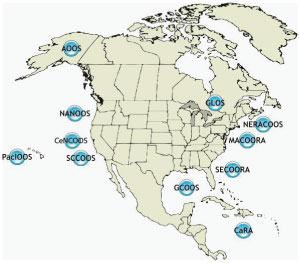Several COSEE Centers have formed successful collaborations with Regional Coastal Ocean Observing Systems (RCOOS). Following is a synopsis of some of the collaborations developed by West Coast COSEE Centers.
| |  |
| Regional Coastal Ocean Observing Systems |
COSEE-Ocean Learning Communities
Ocean Inquiry Project (OIP), a collaborative partner in COSEE-Ocean Learning Communities (OLC), is a founding member of the Northwest Association of Networked Ocean Observing Systems (NANOOS), the regional association of the IOOS in the Pacific Northwest. Fritz Stahr, COSEE-OLC co-PI and President of OIP, is on NANOOS' Executive Committee. Both COSEE PP (Coral Gherke) and COSEE OLC (Fritz Stahr) have representatives on the NANOOS Education and Outreach Committee, which helps to guide NANOOS in its E&O efforts. NANOOS has sent representatives to COSEE-sponsored workshops to speak on ocean observing and to share educational resources available from NANOOS. For example, NANOOS representatives spoke at the Citizen Science Workshop in 2009 (organized by COSEE-OLC), and at a recent workshop for community college instructors organized by COSEE-Pacific Partnerships. NANOOS is working toward being able to integrate citizen science data into its data visualization system, and COSEE-OLC will help guide this effort. –contributed by Amy Sprenger
COSEE-Pacific Partnerships
Since 2008, COSEE-Pacific Partnerships (PP) has collaborated with NANOOS on several activities, and they continue to plan for future opportunities. COSEE-PP Coordinator Coral Gehrke is a member of the NANOOS Education and Outreach subcommittee and COSEE-PP Director Jan Hodder wrote a letter of support for the NANOOS proposal (Fostering citizen science participation in ocean observing in the Pacific NW) to NOAA’s Environmental Literacy program.
In 2010, NANOOS staff and scientists participated in several of COSEE-PP’s professional development activities for community college faculty. Katie Rathmell, a Marine Technician for the Center for Coastal Margin Observation and Prediction (CMOP) (a NANOOS member organization), presented a special session at the 2010 Oregon Academy of Science Meeting on using autonomous underwater glider data in education, particularly in community college courses, and on paths that students interested in this type of ocean science might follow. Dr. Murray Levine, a NANOOS and CMOP scientist and Professor of Physical Oceanography at the College of Oceanic and Atmospheric Sciences (COAS) at Oregon State University, with his COAS colleagues Dr. Fred Prahl, Professor of Chemical Oceanography, and Dr. Ed Dever, Associate Professor of Physical Oceanography, provided a full day of instruction on ocean observing systems during the community college faculty institute at the Hatfield Marine Science Center in Oregon. NANOOS Executive Director Dr. Jan Newton provided community college faculty institute participants at the Shannon Point Marine Center in Washington with an overview of hypoxia in Hood Canal and Coastal Oregon. Newton and NANOOS Education and Outreach Specialist Amy Sprenger also presented a session at the institute on using real-time data in the classroom. -contributed by Coral Gehrke
COSEE-West
COSEE-West's annual Ocean Observing Systems (OOS) teacher workshop has grown incredibly in a very short time. We started with a collaboration with COSEE Coastal Trends, incorporating some of their OOS workshop lesson plans and topics of discussion, along with exposing our participants to ocean observing systems on the East coast. Then, in August 2010, we added on our formal collaborators, the COSEE-West Colorado Collaborative, in the form of a teacher exchange program. Five southern California teachers attended the Colorado OOS workshop in June, learning about ice core data as it related to the study of ancient atmospheres and global climate change, as well as atmospheric interactions with our oceans. Then in August, five Colorado teachers came out and participated in COSEE-West's OOS workshop, learning about various remote sensing tools utilized by scientists in the course of their research.
Participants spent the first day at the University of Southern California (USC) familiarizing themselves with the SCCOOS (Southern California Coastal Ocean Observing System) network and hearing from USC faculty member Dr. Burt Jones and his work with AUVs (autonomous underwater vehicles). Participants spent the second day at the Ocean Institute in Dana Point, where teachers used a remotely operated vehicle (ROV) to explore the sea floor. The third day was spent at the Cabrillo Marine Aquarium where our participants learned about surface circulation and built their own drifters. The fourth day was spent at the Jet Propulsion Laboratory (JPL) learning about satellites, what they monitor in the ocean and what data are available for classroom use. The fifth and final day was spent at the University of California, Los Angeles (UCLA) where participants wrapped up the week, networked with their fellow teachers and continued the development of their lesson plans. COSEE-West also presented this material in an online version of the in-person OOS workshops.
In addition, COSEE-West PI Linda Duguay serves on the Joint Strategic Advisory Committee for SCOOS and the Central and Northern California Ocean Observing System (CENCOOS) -contributed by Jane Lee

